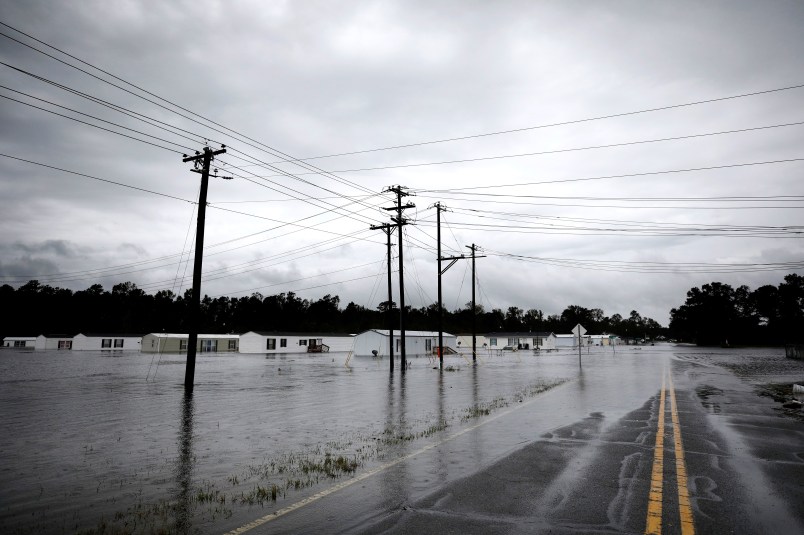WILMINGTON, N.C. (AP) — With Wilmington cut off from the rest of North Carolina by still-rising floodwaters from Florence, officials plan to airlift food and water to a city of nearly 120,000 people as rescuers elsewhere pull inland residents from homes threatened by swollen rivers.
The spreading disaster claimed additional lives Sunday, with at least 17 people confirmed dead, and the nation’s top emergency official said other states were in the path this week.
“Not only are you going to see more impact across North Carolina, … but we’re also anticipating you are about to see a lot of damage going through West Virginia, all the way up to Ohio as the system exits out,” Brock Long of the Federal Emergency Management Agency said Sunday on Fox News.
In Wilmington , the state’s eighth-largest city, residents waited for hours outside stores and restaurants for basic necessities like water. Police guarded the door of one store, and only 10 people were allowed inside at a time.
County commission chairman Woody White said officials were planning for food and water to be flown into the coastal city.
“Our roads are flooded,” he said. “There is no access to Wilmington.”
About 70 miles (115 kilometers) away from the coast, residents near the Lumber River stepped from their homes directly into boats floating in their front yards; river forecasts showed the scene could be repeated in towns as far as 250 miles inland as waters rise for days.
Downgraded to a tropical depression, Florence was still massive. Radar showed parts of the sprawling storm over six states, with North and South Carolina in the bull’s-eye.
Meanwhile, half way around the world, Typhoon Mangkhut barreled into southern China on Sunday after lashing the Philippines with strong winds and heavy rain that left dozens dead. More than 2.4 million people were evacuated from China’s southern Guangdong province ahead of the massive typhoon, the strongest to hit the region in nearly two decades.
In North Carolina, fears of what could be the worst flooding in the state’s history led officials to order tens of thousands to evacuate, though it wasn’t clear how many had fled or even could.
President Donald Trump said federal emergency workers, first responders and law enforcement officials were “working really hard.” As the storm “begins to finally recede, they will kick into an even higher gear. Very Professional!” he declared in a tweet.
The storm’s death toll climbed to 17 when authorities said a 3-month-old child was killed when a tree fell on a mobile home in North Carolina. Three people died in weather-related traffic accidents, officials said.
Victor Merlos was overjoyed to find a store open for business in Wilmington since he had about 20 relatives staying at his apartment, which still had power. He spent more than $500 on cereal, eggs, soft drinks and other necessities, plus beer.
“I have everything I need for my whole family,” said Merlos. Nearby, a Waffle House restaurant limited breakfast customers to one biscuit and one drink, all take-out, with the price of $2 per item.
Kenneth Campbell had donned waterproof waders intending to check out his home in Lumberton , but he didn’t bother when he saw the Coast Guard and murky waters in his neighborhood.
“I’m not going to waste my time. I already know,” he said.
As rivers swelled, state regulators and environmental groups were monitoring the threat from gigantic hog and poultry farms located in low-lying, flood-prone areas.
The industrial-scale farms contain vast pits of animal feces and urine that can pose a significant pollution threat if they are breached or inundated by floodwaters. In past hurricanes, flooding at dozens of farms also left hundreds of thousands of dead hogs, chickens and other decomposing livestock bobbing in floodwaters.
Some stream gauges used to monitor river levels failed when they became submerged, but others showed water levels rising steadily, with forecasts calling for rivers to at or near record levels. The Defense Department said about 13,500 military personnel were assigned to help relief efforts.
Authorities ordered the immediate evacuation of up to 7,500 people living within a mile (1.6 kilometers) of a stretch of the Cape Fear River and the Little River, about 100 miles (160 kilometers) from the North Carolina coast. The evacuation zone included part of the city of Fayetteville, population 200,000.
Near the flooded-out town of New Bern , where about 455 people had to be rescued from the swirling flood waters, water completely surrounded churches, businesses and homes. In the neighboring town of Trenton, downtown streets were turned to creeks full of brown water.
The rain was unrelenting in Cheraw, a town of about 6,000 people in northeastern South Carolina. Streets were flooded and Police Chief Keith Thomas warned people not to drive, but the local food and gas store had customers.
“As you can tell, they’re not listening to me,” he said.







In other words, flood levels higher than anybody had ever anticipated.
Great…try NOT to leave them in some field with no roads going in or out. Thanks.
Why? When you had warning for DAYS that a monster storm was heading your way… do you wait until the streets are flooded and your lives are at risk, to THEN try to run out to stores for supplies? I understand if you just cant evacuate, but at least PREPARE!! You now make the situation worse…